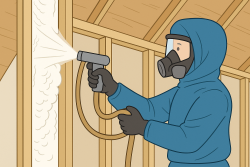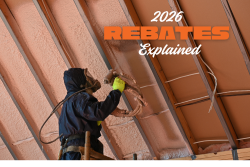Spray foam insulation is increasingly popular among homeowners looking to improve energy efficiency and comfort. With its excellent insulating properties and ability to fill gaps and cracks, spray foam offers a superior alternative to traditional insulation materials. However, choosing the right type of spray foam insulation for your home can be daunting. By following this guide, you can make an informed choice during the selection process.
Understand the Types of Spray Foam Insulation
Spray foam insulation can be classified as open-cell foam and closed-cell foam. Each type has distinct characteristics and applications.
- Open-Cell Spray Foam: It is less dense and has a spongy texture, allowing it to expand significantly upon application. Interior walls and ceilings are typically covered with it, providing excellent soundproofing and insulation for mild climates. Open-cell foam is also more affordable, making it an attractive option for budget-conscious homeowners.
- Closed-Cell Spray Foam: This type of foam is denser and provides a higher R-value per inch, making it ideal for areas that require maximum insulation. It creates a robust and moisture-resistant barrier, making it suitable for basements, crawl spaces, and exterior applications. Although closed-cell foam is more expensive, it offers superior insulation and structural reinforcement.
Assess Your Home's Insulation Needs
Before selecting a spray foam type, assess your home's insulation needs. Consider factors such as the climate, the existing insulation, and the specific areas requiring insulation.
- Climate Considerations: Homes in colder climates may benefit more from closed-cell foam due to its higher insulation value and ability to resist moisture. In contrast, open-cell foam may suffice in milder climates where soundproofing is a priority.
- Specific Applications: Determine which areas of your home need insulation. Closed-cell foam is ideal for basements, attics, and exterior walls, where moisture resistance is crucial—open-cell foam suits interior walls and ceilings, where soundproofing and affordability are more important.
Consider Your Budget
Budget is an essential factor when choosing spray foam insulation. While closed-cell foam offers higher performance, it comes at a higher cost. Open-cell foam provides a cost-effective solution for those with budget constraints.
- Cost Comparison: Open-cell spray foam costs less per square foot than closed-cell foam. However, consider the long-term benefits and energy savings that closed-cell foam might provide, which can offset the initial investment over time.
- Rebates and Incentives: Check for government rebates or incentives that may be available for energy-efficient home improvements. These can help reduce the overall cost of your insulation project.
Evaluate the R-Value
The R-value measures the insulation's thermal resistance, indicating its effectiveness in reducing heat transfer. The higher the R-value, the better the insulation.
- R-Value Requirements: Determine the R-value requirements for your area based on local building codes and climate conditions. In general, closed-cell foam has an R-value of about 6.5 to 7 inches, whereas open-cell foam usually has an R-value of 3 to 4.
- Layering Options: In some cases, layering open-cell foam with other insulation materials can help achieve the desired R-value while managing costs.
Consult with a Professional
Consult an insulation professional to ensure you choose the proper spray foam for your home. They can assess your home's specific needs and recommend the best type of spray foam for your project.
- Professional Installation: Spray foam insulation requires professional installation to ensure proper application and safety. Professional installers have the expertise and equipment to apply the foam correctly and maximize its benefits.
- Expert Advice: A professional can inform you about the latest spray foam technologies and innovations, helping you make an informed decision.
Conclusion
The process of choosing the proper spray foam insulation for your home involves the following:
- It is essential to understand the differences between open-cell and closed-cell foam.
- You are assessing your insulation needs.
- I am considering your budget.
By evaluating these factors and consulting with a professional, you can select the best spray foam solution to enhance your home's energy efficiency and comfort.
At Reitzel Insulation, we provide high-quality spray foam insulation solutions tailored to your needs. Our experienced team is here to help you make the proper selection and ensure your home is well-insulated for years.

















